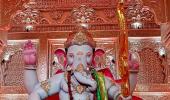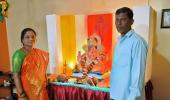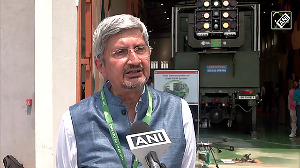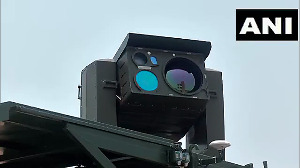Mumbai's historic tryst with the Lord of Wisdom began at the Keshavji Naik Chawl in 1893.
Text: Prasanna D Zore/Rediff.com
Photographs, Video: Satish Bodas/Rediff.com

When Lokmanya Tilak issued a clarion call in 1893 to celebrate the 10-day Ganeshotsav festival as a community event, the intention was not just to honour one of the most most-loved deities in the Hindu pantheon.
Tilak wanted the seeds of Swaraj to take root in the national consciousness through the celebration of a festival that had huge acceptance among the people under the Peshwa rule before the East India company unfurled the Union Jack across India.
When the Lokmanya called

With this call, Tilak, in one swoop, smoothly bypassed the restrictions imposed by the British on government servants joining India's freedom movement that had already begun to take firm root among the masses since the establishment of the Indian National Congress in 1885.
Tilak's associates Rao Bahadur Limaye and Narhari Shastri Godse responded to their leader's message at the Keshavji Naik Chawl in Girgaon, south Bombay.
Nine years later, on September 15, 1901, Tilak again made history by attending the first such public Ganesh festival at the Keshavji Naik Chawl.
From that moment on, Bombay became intricately woven into India's freedom movement.
The city also forged an unbreakable bond with the Lord of Wisdom on a scale and grandeur that has only grown with time.
No pomp, only history

Built between 1860 and 1862 by Marwari businessman Keshavji Nayak -- the name of the chawl later got Marathi-ised to Naik and hence the name Keshavji Naik Chawl -- its residents have carried forward Tilak's legacy for more than 131 years now.
Ensconced snugly in a small lane about 150 metres from Mumbai's hyper-busy Charni Road railway station, the Ganpati festival at the historic Keshavji Naik Chawl is a solemn affair.
There is no ostentatious decoration or loud DJ music that greets pilgrims; it's mostly former residents, people from the neighbourhood and from far-flung suburbs who have heard about this Lord Ganesha who come here to soak in the history of the venue.

A simple flowery carpet laid between Chawls No 1 and 2 -- the Keshavji Naik Chawl is spread across five units -- leads visitors to the non-descript -- in terms of pomp, not historical significance -- lane that is home to Mumbai's first Sarvajanik Ganeshotsav organised by the Shri Sarvajanik Ganeshotsav Mandal.
The ground-plus-two Keshavji Naik Chawl, which is home to some 150 households and 600 people, is minimally decorated with vertical wooden columns, neatly wrapped in white cloth, that support the chawl's structure and a white-clothed mandapam covers the top of the pandal.
"It was in this very courtyard that Tilak addressed a public meeting on September 15, 1901," says Vinod Satpute, one of the residents, narrating the chawl's history.
"The Ganesh murti has a pride of place for more than 130 years in this 165-year-old chawl," he adds.
"Not just Tilak, (Vinayak Damodar) Savarkar also visited the Shri Sarvajanik Ganeshotsav Mandal on April 5, 1952."
The chawl's famous residents

Apart from these famous visitors, the Keshavji Naik Chawl has been home to luminaries like Bombay state's first chief minister Balasaheb Gangadhar Kher, social reformer Keshav Sitaram Thackeray (popularly known by his pen name Prabodhankar Thackeray, he was Shiv Sena founder Bal Thackeray's father), Communist stalwart Shripad Amrit Dange, Socialist stalwart S M Joshi, poet Keshavsut (Krishnaji Keshav Damle), Veer Waman Gopal Joshi (Marathi playwright, journalist and freedom fighter) and the elder of the Kalyanji-Anandji music director duo, Kalyanji Veerji Shah, says Harshad Shirsat, the 38-year-old social media coordinator of the Shri Sarvajanik Ganeshotsav Sanstha, citing a 252-page book, the Sarvajanik Ganeshotsav Shatkachi Vatchal, that chronicles the splendid history of the century-old festival celebrated at the Keshavji Naik Chawl.
This book also enumerates, among its pages, articles and editorials penned by Tilak in 1894, 1895 and 1896, explaining his rationale behind converting a private act of faith into a community activity.
An imposing photograph of Tilak shot by Narayan Vinayak Virkar -- a respected photo journalist who captured the aftermath of the Jallianwala Bagh massacre in 1919; he was also well-known for his portrait photos of Indian leaders -- a contemporary of the man who gave the strength and character to India's struggle for Independence with his 'Swaraj is my birthright and I shall have it' declaration awakening radical nationalist sentiments among the masses.
Preserving a slice of history

The 10-day celebration begins with Bappa's Aagman (the homecoming welcome) on the first day, accompanied by dhol-tasha (traditional Maharashtrian musical instruments) and lezim (one of the many popular Marathi folk dances).
"Once Bappa comes home, there is a carnival-like atmosphere for the next nine days that culminates with the Visarjan at Girgaon Chowpatty," says Shirsat.
"On the days between Bappa's Aagaman and Visarjan, the chawl members organise dramas, quizzes, folk dance competitions, bhajan recitals, a rangoli competition, debates, a fancy dress event, havans and yagnas for our beloved Bappa. It is all traditional," says a member of the Sanstha, who wished to remain anonymous.
"We have a history to take care of. We also have to guard against any commercialisation of the festival and converting it into a money-spinning jamboree. We love what we do and we are proud of our legacy," he adds.
Holding history aloft

Today, the entire teakwood structure of the chawl has made way for a part-concrete, part-wooden edifice. More than 48-odd families have moved out of their tiny, humble abodes to plusher and bigger homes farther up the northern suburbs of Mumbai.
Commercial offices have taken over some of these homes in a city that has everything in abundance but land.
Yet, the spirit of the celebration and camaraderie that the chawl members once shared still remains strong and undaunted by the increased distance.
"I have recently moved to Mira Road (a township north of Mumbai)," says Shirsat. "Every year -- and it's not just me -- many families which have moved out of the chawl ensure that they return for this festival.
"I know the importance of celebrating Ganeshotsav at the Keshavji Naik Chawl. Ours is the fifth generation that is still holding aloft the torch lit by our ancestors on Tilak's calling. The torch will continue to shine bright, upheld by the generations that come after us."
Video editing: Afsar Dayatar/Rediff.com











 © 2025
© 2025